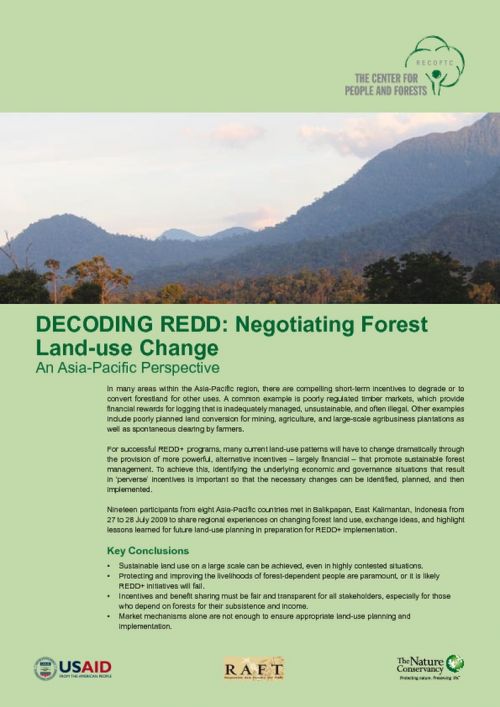APA 6th ed. Decoding REDD: Negotiating Forest Land-Use Change. (2009, August 1). Retrieved from https://voices4mekongforests.org/publications/0000020
MLA 8th ed. Decoding REDD: Negotiating Forest Land-Use Change. RECOFTC, 1 August 2009, https://voices4mekongforests.org/publications/0000020.
Chicago 17th ed. RECOFTC. 2009. "Decoding REDD: Negotiating Forest Land-Use Change." Published August 1, 2009. https://voices4mekongforests.org/publications/0000020.
Decoding REDD: Negotiating Forest Land-Use Change

In many areas within the Asia-Pacific region, there are compelling short-term incentives to degrade or to convert forestland for other uses. A common example is poorly regulated timber markets, which provide financial rewards for logging that is inadequately managed, unsustainable, and often illegal. Other examples include poorly planned land conversion for mining, agriculture, and large-scale agribusiness plantations as well as spontaneous clearing by farmers.
For successful REDD+ programs, many current land-use patterns will have to change dramatically through the provision of more powerful, alternative incentives — largely financial — that promote sustainable forest management. To achieve this, identifying the underlying economic and governance situations that result in ‘perverse’ incentives is important so that the necessary changes can be identified, planned, and then implemented.
Nineteen participants from eight Asia–Pacific countries met in Balikpapan, East Kalimantan, Indonesia from 27 to 28 July 2009 to share regional experiences on changing forest land-use, exchange ideas, and highlight lessons learned for future land-use planning in preparation for REDD+ implementation.
Key Conclusions
- Sustainable land-use on a large scale can be achieved, even in highly contested situations.
- Protecting and improving the livelihoods of forest-dependent people are paramount, or it is likely REDD+ initiatives will fail.
- Incentives and benefit sharing must be fair and transparent for all stakeholders, especially for those who depend on forests for their subsistence and income.
- Market mechanisms alone are not enough to ensure appropriate land-use planning and implementation.

